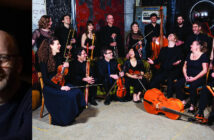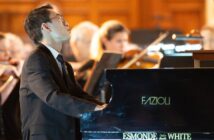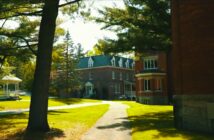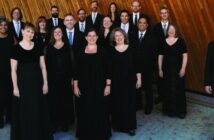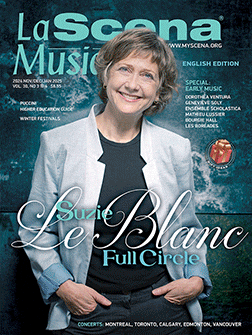This page is also available in / Cette page est également disponible en:
![]() Francais (French)
Francais (French)
Montreal, 29 July 2017—It is with great sadness that we announce the passing of composer, pianist, and pedagogue Gilles Tremblay this past Thursday at the age of 85.
Read the SMCQ’s tribute to Mr. Tremblay here (french).
This cover article is from La Scena Musicale – Vol. 15, No. 2 October 2009
The 2009-2010 music season will by highlighted by an exciting tribute to composer Gilles Tremblay. More than 60 concerts featuring the composer’s works will be performed in Montreal, Quebec City, and Drummondville, as well as outside Quebec. In November, Chant Libres presents the world premiere of his fairytale opera, L’eau qui danse, la pomme qui chante et l’oiseau qui dit la vérité (the libretto is by poet and playwright Pierre Morency), and in February, the Montreal Symphony Orchestra will create L’origine, a major work for mezzo-soprano and orchestra. Lecture presentations will be among the events, and works will be commissioned from some of his numerous former students. Future music fans won’t be left out, as the tribute will include the launch of a comic album on the composer’s achievements, and presentations in schools.
This is the first in a series of articles we are dedicating to the composer. This month, we propose a biographical sketch, and a portrait of Gilles Tremblay through some of his writings. Starting in November, you’ll discover the story behind the creation of his opera.
Born in Arvida in the Saguenay region in 1932, the eldest in a family of five children, Gilles Tremblay began his musical studies in Montreal, under Claude Champagne, Jean Papineau-Couture, Isabelle Delorme, Jean Vallerand, and Germaine Malépart. He moved to Paris to attend Olivier Messiaen’s famous music analysis classes, and in the summer, attended contemporary music seminars in Darmstadt, benefitting from encounters with musical giants Pierre Boulez, Karlheinz Stockhausen, Iannis Xenakis, Henri Pousseur, and Pierre Schaeffer.
A born communicator
When he returned to Quebec in 1961, Tremblay began to teach his own analysis courses, which were appreciated by several generations of students, including Claude Vivier, Walter Boudreau, Yves Daoust, Isabelle Panneton, Serge Provost, Jean Lesage, Estelle Lemire, and Kiya Tabassian. In his classes, the material varied from Gregorian chant to the operas of Monteverdi, from Mozart to Varèse. The following year, he was asked to give the analysis course at the Conservatoire de musique de Montréal and was put in charge of the CMM’s composition courses in 1967; he remained in both these positions until his retirement in 1997. “The best way to learn composition techniques and composition is by analyzing works: examining the problems that beset the composers of today and yesterday and how they solved them. […] It is through the analysis of works that composers’ minds awaken to musical realities; at the same time, it constitutes a kind of fieldwork, an extremely rich soil as a source of inspiration for their own works,” he explained to Marcelle Guertin in the cultural review Dérives in 1984. “Tremblay makes us discover a world in which history does not appear as a series of ruptures, but on the contrary, as an element of continuity in the search for a living, personal expression of music,” explains Marie-Thérèse Lefebvre, who has written a number of articles on the composer.
Gilles Tremblay’s heavy workload did not prevent him from being intensely involved, along with his comrades in arms, Serge Garant, Otto Joachim, Pierre Mercure and François Morel, in the active dissemination of the contemporary music of Quebec. He composed uninterruptedly, fulfilling a large number of commissions, including responsibility for the sound design of the Quebec Pavilion at Expo 67, for which he was awarded the Prix Calixa-Lavallée. Through the years, he has composed many important works, which include: Fleuves (1976); Vers le Soleil(1978); Compostelle I (1978), on the occasion of Messiaen’s 70th birthday; AVEC – Wampum Symphonique (1984), for the 350th anniversary of the founding of Montreal; L’Espace du cœur (1997) with interwoven texts by Guillaume de Machaut and Gaston Miron; À quelle heure commence le temps? (1999) a lyric monodrama from a text by Bernard Lévy; and Les Pierres crieront(1998), a work for cello and orchestra first performed by the Orchestre national de France.
Between tradition and modernity
The links he constantly established between different eras and styles in his classes were also reflected in his musical language – contemporary, but without breaking with his predecessors. In 1980, he wrote in the magazine Possibles: “Yes to our roots, no to attachment to the past, no to interventionism in culture, no to self-negation!” And in an article in Dérives: “To compose is to make the connection between ideas, and, at the same time, to be receptive to an effusion of sound-thoughts that range from the child’s heaven to weeping or laughter. There is a great proximity between these instinctive impulses and composition, even if the latter is organized by intelligence. Composition remains very close to visceral and mental experience. In this sense, composing in 1984 is almost the same as in 1684, or before, in 5000 B.C. However, the functions have changed historically, and composing in 1984 is to be aware of the state of the world in this year of 1984, in the same way that a composer in 1684 may have been more or less conscious of the state of the world at that time. I quite understand that composers are capable of abstracting themselves from time and space, but personally, I strongly believe in this awareness of the time in which one lives, a time that contains one’s drama. I also think that it’s possible to be detached from it at the same time.”
In a 1989 lecture at the Conservatoire de Lyon in one of the “Rencontres du centre Jacques-Cartier”, Tremblay explained his view that three components, memory, evolution, and constellation, remain essential in the elaboration of the musical form. “We should remember that music, being essentially an art of time, the fact that we can remember and therefore, fix moments by means of memory is what gave birth to all the repetitive forms (litanies, the repetitive music of very short cycles dear to the recent American schools, and to the very lengthy and infinitely more subtle cycles of Javanese gamelan music), as well as to forms with the most diversified types of refrain (from the simple A-B-A to the most elaborate rondos). Practically all the classical forms issued from these, and they are found in all civilizations, which makes them, by their universality, true formal archetypes.
“As for evolution (the second component), it allows the work to evolve in a straightforward progression, in one stroke, unable to turn back, in perpetual renewal, pure variation, open to meandering, to dreaming, to happenstance; an attentive wandering, taking all the risks of exploration. The energy that advances towards otherness is surely one of the most fecund in terms of the revelation of forms, and one of the most stirring in the creative process.
“The idea of constellation (the third component) corresponds to an aggregate of objects, sounds, rhythms, timbres, events that may be very far from each other (even outside sound: movement, colour), but are unified by a harmony (in the broad sense of the word) that creates equilibrium.”
The work of art as a sacred act
To Gilles Tremblay, the alchemist of sound, every work has a sacred dimension. He clarified in Dérives: “To me, there is, in the act of creating – I don’t much like the word creation because I think that man continues creation, or reveals creations – an aspect which is very close to the sacred. In every work, even the most profane, this aspect is present, in that the creative act invokes the sense of awe or wonderment; as much in the maker of the work as in the listener who comes into contact with it. At the same time, the maker of the work is made by this wonderment, and I think that’s the essential reason that drew me to religious themes, as in Souffles or Oralléluiant. […] I cannot dissociate the creative act from the sacred: there is a sharing of the wonderment with all the God-praising manifestations, human or natural: waterfalls, birdsong, Gregorian chant, African or Indian music… there is a kind of a hallelujahing movement that envelops it all. It doesn’t matter whether a person is religious or not: to me, awe seems to be at the source of everything, the basis of all possible life among beings.”
Nature itself is perceived within an ecological reflection – an awareness that Tremblay has always shared with his great friend, the astrophysicist Hubert Reeves, honorary chairman of the tribute – and as a means of acceding to the divine. He expressed this idea in Le Devoir on June 27, 1970: “The sunrise, a political event, the song of a cicada or of a bell, a volcanic eruption and silence are not so far from each other as it may seem at first. For the musician, to hear, to perceive the musical relations that exist in life already constitutes a musical act. To him, in any case, the attraction grows ever stronger. If he prolongs this act of unified reception by articulating the work onto the perceived music I just mentioned, then the work enters a completely new dimension, nourished by movements that go beyond it. If, in turn, the work helps the listener be aware of the latent music that surrounds us, then, the musician is fully rewarded.”
A poet, philosopher, idealist, believer, teacher, banner, beacon: Gilles Tremblay is all that and more. For over 50 years, he has been questioning and renewing himself, redefining sound and silence and pushing back both the limits of language and his own limits, but above all, he has never ceased to inspire music lovers and creators. In the November 17, 1984, issue of Le Devoir, he said: “Precisely because of the drama of our times, but also because of the sparks that punctuate this night – messengers of the promise of warmth –, a kind of urgency prevails, as imperious as it is irrational: the essential necessity to write, to participate in the rhythm that is the cohesion of the universe, that holds it together from the molecule to the stars, from the cycle of the seasons to the heartbeat, as if that rhythm were the palpitating conveyor of the first surge of life up to the shores of the present. The act of the Creator. At the heart of the drama, the very strength of the song lies in its fragility, on the brink of silence.”
[Translation: Darcy Dunton]
This page is also available in / Cette page est également disponible en:
![]() Francais (French)
Francais (French)



